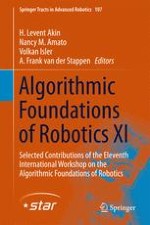This carefully edited volume is the outcome of the eleventh edition of the Workshop on Algorithmic Foundations of Robotics (WAFR), which is the premier venue showcasing cutting edge research in algorithmic robotics. The eleventh WAFR, which was held August 3-5, 2014 at Boğaziçi University in Istanbul, Turkey continued this tradition. This volume contains extended versions of the 42 papers presented at WAFR. These contributions highlight the cutting edge research in classical robotics problems (e.g. manipulation, motion, path, multi-robot and kinodynamic planning), geometric and topological computation in robotics as well novel applications such as informative path planning, active sensing and surgical planning. This book - rich by topics and authoritative contributors - is a unique reference on the current developments and new directions in the field of algorithmic foundations.
